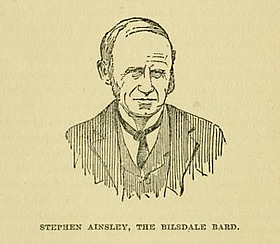Family Tree
Stephen and Charity Ainsley Branch
Images and information content subject to copyright
- please do not use or reproduce anything from this website without permission, (which isn't usually a problem), acknowledgement and link - email for more information.
Website
created and updated by Alyson Jackson (launched 2002).
Stephen and Charity Ainsley were my great-grandparents. This page is devoted to them and their descendants and includes material which has been kindly donated by relatives - please do not use anything from this page, particularly photographs, without first obtaining permission. Numbers in brackets after names are the numbering system of William C Ainsley on the Bilsdale Family Tree.
Origins at Spout House, Bilsdale
| John(3) and Hannah Ainsley | siblings of John: William, Thomas, Alice, Richard, Stephen, Mary, Peggy and James | |||||||
| William (4) and Amelia/Emma Ainsley | siblings of William: Nanny, John, Joseph, Thomas, Stephen, Mary, James, Hannah and Richard | |||||||
| Stephen (42) ch 16-03-1835 d 14-12-1910 Spout House m 06-11-1871 Charity Featherstone b 18-06-1854 d 19-03-1916 |
siblings of Stephen: Hannah, William, Mary, Amelia, Sarah, Martha, Joseph, James, Elizabeth and Margaret | |||||||
| Joseph William (42-1) ch 12-10-1873 m 24-11-1903 Eliza Frankland |
Annie (42-2) b 09-08-1875 ch 05-10-1879 m 07-03-1901 Robert Carlton Moore |
James Henry (42-3) b 05-12-1876 ch 05-10-1879 m c. 1908 Mary M ? b c. 1877 |
Emma (42-4) b 04-09-1878 ch 05-10-1879 m 27-04-1901 Joseph Wheldon |
John Featherstone (42-5) ch 11-09-1880 m c. 1911 Lois ? b c. 1887 |
Jane (42-6) ch 13-01-1884 m 18-07-1903 William James Hill |
Margaret (42-7) ch 11-04-1886 m 18-07-1914 Herbert Allison |
Stephen (42-8) ch 27-05-1888 | Harry (42-9) ch 17-11-1890 d 29/08/1918 |
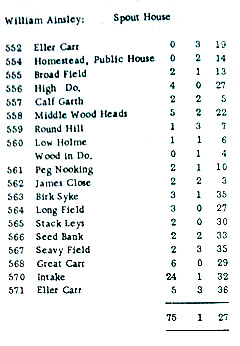
The entry for Spout House from the Bilsdale Survey of 1826. The numbers on the left refer to maps published in the survey.
It is not until the nineteenth century that an Ainsley is recorded at Spout House. In an 1826 survey1 the entry for Spout House clearly includes the Public House with William Ainsley as the tenant. This William is Stephen's (42) father.
Stephen Ainsley (42) was born to William and Emma Ainsley at Spout House on the 16th of March 1835. William is said to be a farmer on the registration, and not an innkeeper. The census of 1841 describes William, aged 55, as a farmer at Spout House, living with his wife Amelia, aged 30 - his wife is variously recorded as Emma and Amelia - and with their children Hannah, William, Mary, Stephen aged 6, Amelia, Sarah and Martha. The eldest child, Jane,would have been 16 and is not recorded in the household - she could have been away visiting or may well have left home at this point to work in service.
Ten years later William and his family - including Jane with her children Alice and Henry, and newer arrivals Joseph, James, Elizabeth and Margaret but without Mary and Martha - remain at Spout House; he is described as a farmer of 75 acres with one labourer. Stephen's occupation is not given, though at 16 he would not still be at school. Mary was actually visiting her maternal grandparents and Martha, at 11 years old a scholar, was with her Uncle James and Aunt Mary Ainsley at Bank House.
In 1861 the census shows that the family has been split up, no doubt due to the death of Amelia in 1852. Stephen and his sister Elizabeth are both working as farm servants in the household of their sister Mary who had married William Dale but was now a widow.
In 1871 at the time of the census Stephen remained unmarried but was now a farmer in his own right, farming 80 acres at Cow Helm, in Bilsdale with his sister Emma as housekeeper. On the sixth of November he married Charity Featherstone, no doubt putting Emma out of a job. Emma had had a child in 1871, though she was unmarried at the time - a not uncommon occurrence.
Stephen was a staunch and long time member of the famous Bilsdale Hunt. His brother-in-law Nicholas Spink was huntsman from 1870 to 1886, and then jointly with Robert Garbutt until 18875 . The equally famous Bobby Dawson was for sixty years whipper-in for the Bilsdale Hunt, following the hunt all his life from the age of twelve to his death at the age of ninety in 19025 .When Bobby Dawson died Nicholas became the oldest member of the Bilsdale Hunt5 . and both he and Stephen were present at Bobby Dawson's funeral, as were many prominent hunt members.
It must be remembered that at this time foxes were regarded as little more than vermin but it seems there were, even in the late nineteenth century, people vehemently opposed to fox-hunting. Their form of protest was to lay poison for the hounds. A number died and Bobby Dawson wrote a note to J. Fairfax Blakeborough, author of "England's Oldest Hunt"5, asking that it be published:
BILSDALE HOUNDS
Who met at Buck Inn, Chopgate, on Tuesday, November 26th, at 10-30. A fair lot of horsemen were there, and about 40 on foot; through being a foggy morning was delayed until 11-30, then left Chopgate and went up the Green through the Bilsdale Hall to horro (Orra) planting, where the hounds threw off. They got on a drag and were soon away at a rattling speed, they running strait for Middle Head Crag, where foxes are very often run to ground after a few minutes' spin. Someone had a spite against hunting, were trying to destroyed [sic] the hounds by laying poison. One of the leading hounds got it, and died on the spot, about one mile from Chopgate. After a bit of delay Bobby Dawson was there, he swore it was the best dog in the pack. Bobby says 'it is our best plan to gether up the hounds and gan away yam or we lowse every dog in the pack.' This dog was kept by Mr. Ainsley, Sun Inn, Bilsdale, who is noted for keeping the best dog in the pack. £5 reward.
Dawson was a strange character. Apparently he starved his hounds, his horses and himself, seems not to have been interested in the actual chase but loved to see the hounds worked - and he could not bear to kill a fox5 !
When she was 6 in 1861 Charity had been living in Grange with her parents Joseph and Hannah, and her siblings Sarah, Meshack and Jane. On one side of her own home were two Ainsley households: James aged 83 a widower and Stephen's (42) great uncle, and John and Jane Ainsley with their children William and Mary - John was the son of Thomas, brother of Stephen (42)'s father William. So Charity would have been well acquainted with the extensive Ainsley family. Just prior to her marriage Charity was working as a general servant in the Johnson household at Ewe Court near Grange.
Stephen and Charity Together
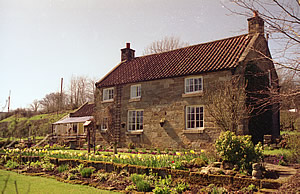
Bridge End Cottage, Eller Bridge
By 1881 Stephen and Charity had settled at Cow Helm, farming 99 acres. Their first five children Joseph, Annie, James, Emma and John were with them, but ten years later everything has changed. Stephen was then 56 but no longer farming in his own right - the family were living at Bridge End cottage, at Eller Bridge. Their five youngest children were with them: John, Jane, Margaret, Stephen and Harry, but the elder Stephen was only an "agricultural labourer" (actually a stonemason - see below). What happened? The farms of Bilsdale are predominantly sheep farms and the 1880s saw some very bad weather, with the added effect of the eruption of Krakatoa in 1883 which led to a world depression of temperature by 0.5C2 - perhaps this was the cause of decline. However, a contact at the Yorkshire Farming Museum provided a less exotic reason:
The late nineteenth century was a difficult period for British farmers, due largely to the burgeoning world market. For example the development of the railways across the continent allowed for easy transport of surplus corn to the British East coast. By 1866 following the end of the American Civil war, trade with America was on the increase too. In 1880 the first successful shipment of frozen meat arrived in Britain from Australia. All these factors started to have a detrimental impact on British farmers and devalued their own produce significantly. A quarter of wheat in 1882 would have fetched 45 shillings, by 1889 it was down to 30 shillings and by 1894 the same quantity would only fetch 24 shillings. (A quarter is equal to eight bushels, or approximately one-quarter of a ton).
In 1875 wheat was grown on 3,000,000 acres in Britain, by 1895 it was only grown on 1,500,000 acres; half the coverage of twenty years earlier. Ironically, many farmers adopted the use of machinery at this time as it was seen as a long-term cost saving measure; reducing the need to pay numerous labourers.
The four eldest had moved out in 1891 to find work - three of them outside of Bilsdale. Joseph was a farm servant with the Dall Family at Stone House Court, in the northern part of the dale near Bank House. Annie was working as a general domestic servant in the Armstrong family in Stokesley. James Henry had moved to Hutton in the ecclesiatical parish of Rudby, west of Stokesley, to work as a farm servant with the Weighill family at Over Green. Finally Emma was employed as a domestic servant in the household of Sidney Harries in Carlton just south of Stokesley. All are still within the Stokesley district but it is, perhaps, indicative of a growing population in the dale and the increasing difficulty of finding work.
In 1901 Stephen and Charity were still at Ella Bridge with Emma, Stephen and Harry, but ten years later Stephen had died and Charity lived there with son Stephen, now a blacksmith. The census records that Charity had ten children, but only nine survive to this point - who was the tenth child?
An extract from Balkeborough's "England's Oldest Hunt"5 from his diary entry for November 9th, 1903, provides a lovely insight into Stephen's character:
Yesterday I was at the Bilsdale Hunt dinner at Chop Yat. It was an enjoyable function. Chappie Garbutt was there, also Stephen Ainsley. The former said he would commit suicide if the hounds went down; it was the only bit of "re-creation" they got." Steve, too, was quite lively, and sang a number of his interminable hunting songs - some of them with more than forty verses, said and believed to have been composed by himself, but which peculiarly enough I find, with altered place-names and facts, in the "Badminton Library: the Poetry of Sport," as having been written a century before Stein saw the light. I would not say so for the world for Bilsdaleites will tell you no one sings like Stein, and no one has such songs to sing either. He himself tells a story of how at one of the Earl of Feversham's rent audits the then agent asked for "just forty verses of that song of yours." Steven [sic] is on the Committee of the Bilsdale Hunt, and years ago regularly followed the pack on foot, and occasionally on a "gallower." He is a stonemason by trade, of Scotch extraction, and one of a big family. He was born at the quaint old Spout House, kept by his elder brother and they show you the marks yet on the old stone-mullioned window where the young Ainsleys sharpened their knives prior to sitting down to dinner. Stein once told me that "breedin' will tell, an' a dowter of his had married yan Wheldon, a blacksmith at Hawnby. Sha used ta be 'at sha wad run whal sha brust efter t'hoonds, an' wad hev hed me keep all t' dogs in t' pack. Ah ewsed ta keep yan reglar i' them daays, an' well sha waited on it" (i.e. attended to it).
Apparently Stephen was always known as "Stein" in Bilsdale5 - a concidence that it is the German word for "stone"?
Charity is said to have been a jolly, friendly woman, as William Cyril Ainsley says6:
...apparently Charity was a real 'character', fond of a gossip to such an extent that when she went to draw water every day at the communal tap or spring, her neighbour, also needing water, would wait for Charity to return home first rather than risk 'getting caught'!
Charity died in 1916 in the midst of the turmoil of the Great War, with two sons serving overseas.
Sons and daughters: Joseph William, Annie, James Henry, Emma and John Featherstone
Joseph William (42-1) was employed in the Leckenby family at Seave Green in 1901 as a horse waggoner. Two years later he married Eliza Frankland and at the 1911 census he had become a platelayer in Darlington where their two children had been born: Charles William aged 4 and Robert Ernest aged 2 - sadly they had also lost one child. Joseph was employed by the North Eastern Railway Company and the family were living at 38 Charles Street, North Road, Darlington. Joseph William was not mentioned as a surviving relative on Harry's military papers and so must have died prior to 1918.
At the time of the 1901 census Annie (42-2) was already married to Robert Carlton Moore and they were both boarding with John Lee and his wife in High Green, Stokesley where Robert was self-employed as a Horse Breaker Groom. Ten years later they had their own home at Quarry Farm at Preston-on-Tees, Eaglescliffe and five children: Annie aged 9, Irene aged 8, Guy Carlton aged 6, James Carlton aged 4 and Lilian aged 1. Robert was still a horse breaker. They had moved about a bit in the ten years, the first two children were born in Kirby-in-Cleveland but the two boys were born in Stockton and finally Lilian in Eaglescliffe, suggesting they hadn't been long in their present home. From Harry's service papers we know that the Moore family were living at Middleton St., Darlington in 1918.
James Henry (42-3) emigrated to the USA in 1898 and became a naturalised citizen the following year. In the 1920 census he was living in Granby, Grand, Colorado and owned his own home - though it was mortgaged at this time. His wife Mary was also English and she had emigrated in 1899, becoming naturalised in 1901. They married some time around 1908 and had three children: William aged 11, Margaret aged 9 and Kenneth aged 7 - all born in Montana. Ten years later they were still in Granby and William B. and Kenneth J. were with the family but Margaret is missing from the schedule and William is reported as having been born in North Dakota (though the writing is a little difficult to decipher!).
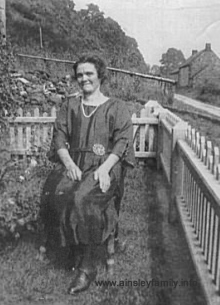
Almost certainly Emma Ainsley in the garden of the forge at Hawnby.
With thanks to Kevin Coyne and Margaret Lamb.
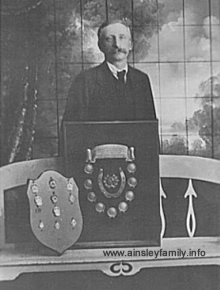
Almost certainly Joseph Wheldon with plaques for horse shoeing competitions.
With thanks to Kevin Coyne and Margaret Lamb.
In the 1901 census Emma (42-4) was still at home with her parents and brothers Stephen and Harry but later that year she married Joseph Wheldon and in 1911 they were living in Hawnby with their five children: Stephen William 8, John Henry 7, Arthur Wilson 5, Cyril Watson 2 and Harold Ainsley 1. Joseph Wheldon was a blacksmith and Emma's brother Stephen was apprenticed to him. From Harry's service papers we know that the Wheldon family were still in Hawnby in 1918.
The two photographs were sent by Kevin Coyne, great grandson of John Featherstone Ainsley, with attributions confirmed by Margaret Lamb, grand-daughter of Emma and Joseph.
Emma is the daughter mentioned in the extract from "England's Oldest Hunt".
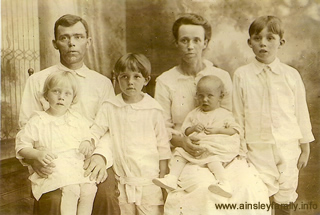
John Featherstone Ainsley, wife Lois Ainsley and from left to right the children are Ernest Harry, John Kermit, Lois (born June 1918 in Beaver Creek, Montana and still living in 2011), and Stephen.
With thanks to Kevin Coyne.
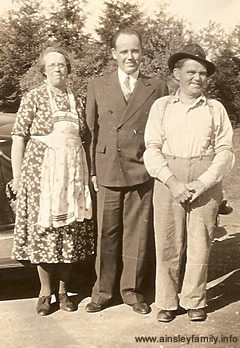
John Kermit Ainsley with
his parents John Featherstone Ainsley and Lois Ainsley.
With thanks to Kevin Coyne, grandson of John Kermit Ainsley.
In 1901 John Featherstone (42-5) was a horseman on the Weighill family farm at Tanton, Stokesley and his sister Jane (42-6) was also there, employed as a domestic servant. He too emigrated to the United States, in 1903, and became naturalised in 1913. In 1920 John was living in Marmarth, Slope, North Dakota, a railroad labourer with a wife, Lois, and four children: Stephen aged 8, John Kermit aged 6, Ernest Henry aged 3 ¾ and Lois Elizabeth aged 1 ½. The two eldest children had been born in North Dakota, the two youngest in Montana. As James Henry's first child is listed in the 1930 census as having been born in North Dakota, it suggests that the two brothers lived relatively close to each other for some time, and it is not unreasonable to assume that when John first emmigrated he went to stay with his brother. John owned his own home, though it ,too, was mortgaged.
John's wife was from Kansas, her father from Massachusetts and mother from Iowa.
In 1930 the family were living in Lake Forest Park, King, Washington, all four children still at home, the eldest recorded as Steven W., the other three as Kermit, Harry and Lois and the family name as Ainslie. John's home was valued at $1000 and he was working as a janitor in a department store.
The photographs are reproduced by kind permission of Kevin Coyne, great grandson of John Featherstone Ainsley.
Daughter Jane and her Family
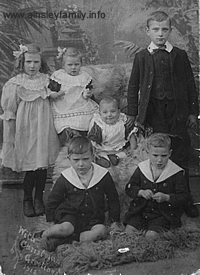
Children of Jane and William James Hill. Inscribed "With Christmas Greetings 1912"
Mary, Nell, Fred
Harry
Jack, Jim
Jane (42-6) married William James Hill in 1903, only one month before she gave birth to their first child, and we have always been told that the family moved to the north east of England to find work and that William James Hill was one of the workforce employed to build Crimdon Railway Viaduct which opened in 19053. However this would have been relatively short-lived employment and in the 1911 census he is recorded as a miner. At this time the mines were booming and were by far the biggest employers in the area.
Blackhall Colliery was opened in 1909 but did not start to produce coal until 19144. In the 1911 census WJ Hill is recorded as being a colliery sinker which fits perfectly - he would have been occupied in the work of sinking the shafts to enable the coal seams to be reached. At this time they had five children and the census records them as living in a two room house 30 Second Street, Blackhalls Colliery, Castle Eden, Durham - it's hard to imagine how they managed. In the schedules a kitchen would count as a room but the houses on Second Street are all two bedroom terraces so maybe there was an error filling in the form.
William and Jane went on to have seven more children later moving to Ninth Street and East Street in Blackhall, still only two bedroom houses. From Harry's (42-9) service papers we know that the Hill family were at 41 New 9th St, Black Halls Colliery, Castle Eden in 1918. They were living in 16 East Street when my father, Robert Ainsley, was born. Fred was the only child born in Bilsdale at Bridge End Cottage, Eller Bridge - all the other children were born in the north east.
To read more about this branch of the family please go to WJ Hill & Jane Ainsley
Sons and daughters: Margaret, Stephen and Harry
Margaret (42-7) was a domestic servant in both the 1901 and 1911 census. First with the Garbutt family at Crookleith in Bilsdale, then with the Webster family at Ings House, Great Broughton south east of Stokesley and very close to Kirby-in-Cleveland. In 1914 she married Herbert Allison who in 1911 was a waggoner on a farm with his uncle's family in Bilsdale - the farm being Cow Helm where Stephen and Charity had farmed many years before. From Harry's service papers we know that the Allison family were living at Rugby Villa Cottage, Middleton St George, Darlington in 1918.
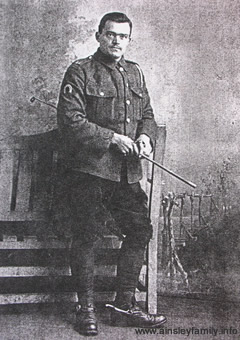
Stephen, son of Stephen & Charity
In 1911 Stephen (42-8) was living with his mother in Bilsdale but he had been apprenticed to Joseph Wheldon, his sister Emma's husband, in Hawnby. Not long after war broke out Stephen joined up, on the 9th November 1914 and served abroad as a farrier - he thankfully survived his military service and also the 1918 flu epidemic. His service papers provide us with some physical characteristics: on enlistment he was 5ft 4in tall, weighed 136 lbs and with an expanded chest of 37½ inches with a dark complexion, brown eyes, dark brown hair. It is also noted that he was a Wesleyan. The photograph on the left was very kindly sent by Margaret Lamb, grand-daughter of Emma and Joseph Wheldon, and has been positively identified as Stephen by comparison with a newspaper cutting which published the same portrait.
William Cyril Ainsley, who created the Bilsdale Family Tree on this website, sent a snippet to me about Stephen:
Stephen, born 27/5/1888, son of Stephen & Charity, Ella Bridge, served his apprenticeship as blacksmith with William Dawson of Great Broughton and then worked "at various shops including Sandersons at Chop Gate and Paxtons at 'Pity Me', County Durham before finally settling at his own shop at Neasham near Middleton-St-George". He died 20/7/1968.
Stephen was definitely apprenticed to Joseph Wheldon, as we know from his military papers. He could have served a second apprenticeship in Great Broughton, though this is unlikely, or he might have been an assistant to William Dawson.
Sadly, Harry (42-9) was not so lucky. He too had been apprenticed to a blacksmith - William Dawson of Great Broughton - and he was living with the Dawson family in 1911. He joined up five days after his brother Stephen and also served as a farrier. With his service papers is a letter of commendation from his employer, Wm Dawson, Implement Maker and Agent, of Great Broughton:
This is to certify that Harry Ainsley has been in my employ as Farrier for 8 years & is a good workman honest & obliging.
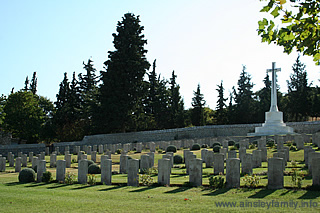
Kirechkoi-Hortakoi military cemetery, 15km north east of Thessaloniki, where Harry is buried.
Harry had the great misfortune of being posted to Salonica where the conditions were as deadly as the enemy.
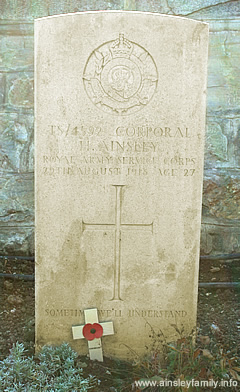
He was first diagnosed with malaria in 1916 and sent to Malta on the hospital ship Formosa. Thereafter he suffered periodic attacks of malaria until he died at the 8th General Hospital Salonica on the 29th August 1918. His military service papers provide us with some idea of what Harry looked like: he was quite short at 5 ft 4½ in tall and weighed 125 lbs with a fully expanded chest measurement of 37 inches he was quite a stocky fellow.
On the 29th August 2011, exactly 93 years after his death, I visited Harry's grave in Salonica with my husband. It was a very emotional experience but good to see how well he was being looked after by the caretakers, whom we met and talked to. Though they had not a word of English, and I not a word of Greek, I was able to sketch out a family tree to show how Harry and I are related - he is my great uncle. As usual the CWGC cemetery was immaculate.
References
- "Bilsdale Surveys, 1637-1851" edited and transcribed by M.Y. Ashcroft & Audrey M. Hill; North Yorkshire County Record Office Publication No. 23; January 1980.
- Booty Meteorological Information Source http://booty.org.uk/booty.weather/climate/1850_1899.htm
- The Durham Coastal Footpath through the District of Easington [PDF]
- Website of the Durham Mining Museum - Blackhall Colliery www.dmm.org.uk/colliery/b006.htm
- "England's Oldest Hunt",J. Fairfax Blakeborough, 1907; free online copy
- W.C. Ainsley research
Last updated September 2013

